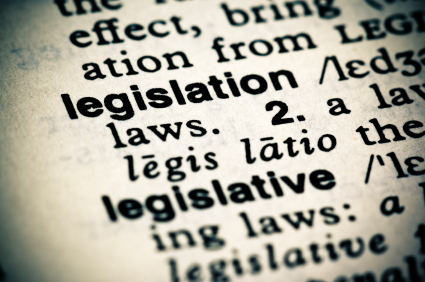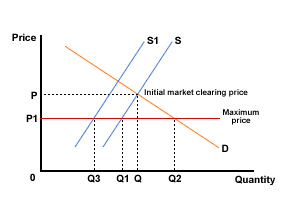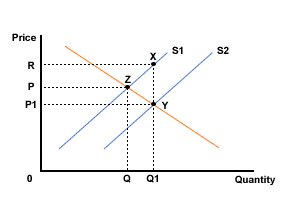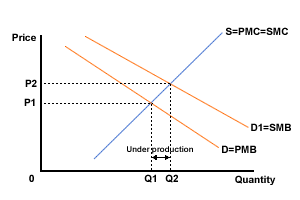Government responses - merit goods
Possible government responses to the under-provision of merit goods
 One solution would be for the government to play no role whatsoever and to allow the provision of merit goods to be decided completely through the free interaction of market forces. However, for all the reasons previously mentioned, this would lead to extreme under-provision of these goods and a misallocation of resources from the standpoint of society as a whole. Thus, in practice, governments play a substantial role in the provision of merit goods such as health and education, even where they are ideologically committed, as the present Conservative government is, to the market system. However, the exact form that such government involvement should take is a subject of much dispute, and we shall consider each of the following in turn:
One solution would be for the government to play no role whatsoever and to allow the provision of merit goods to be decided completely through the free interaction of market forces. However, for all the reasons previously mentioned, this would lead to extreme under-provision of these goods and a misallocation of resources from the standpoint of society as a whole. Thus, in practice, governments play a substantial role in the provision of merit goods such as health and education, even where they are ideologically committed, as the present Conservative government is, to the market system. However, the exact form that such government involvement should take is a subject of much dispute, and we shall consider each of the following in turn:
- direct government provision
- regulation
- subsidies
- a combination of government provision and market forces
Direct government provision
Traditionally in Western Europe the overwhelming majority of health care and education is still paid for out of general taxation and provided free at the point of contact by the government - for most people, when they visit their doctor, go to hospital, school or college, no direct charge is levied upon them; the private sector still only accounts for a relatively small proportion of all health and education provision. Apart from generating substantial positive externalities and overcoming the problems arising from unequal income distribution, lack of current and future information and potential private monopoly power, direct government provision may also give rise to large economies of scale, and may thus be productively efficient; for example, when a service such as health care is provided to the population as a whole, greater scale economies are likely to arise in terms of capital and labour costs than could be expected to accrue to the private health care sector, whose scale of operations is necessarily much smaller than that of the NHS.
However, the idea of universal provision for all on the basis of need, with prices and profits playing no role, is one which sits very uneasily with the philosophy of market economics, and has thus in recent years come under fierce attack from right-wing, market-oriented economists. They have argued that government provision of health and education has led to an undesirable situation of state monopoly power in these areas and that to increase consumer choice, lower costs and raise the level of efficiency, greater competition is required.
Regulation
The government may also use a range of regulatory devices both to increase the consumption of merit goods and to ensure their quality. In the case of education, it may be compulsory that all children between the ages of 5-16 receive some form of schooling, be it in the private or public sector, and quality is controlled in such ways as school teachers being required to have stipulated qualifications before they are allowed to teach. In the case of health care, vaccinations against various contagious diseases could be made compulsory and medical practitioners such as doctors, dentists, opticians and nurses could be required to obtain certain qualifications before they can practice. The government could also use regulation to enforce the consumption of a good provided by the private sector which is deemed to be a merit good by virtue of the positive externalities that it generates: the compulsory consumption of seat-belts by motorists provides one such example.
In the case of housing, the use of rent controls on private sector rented accommodation are a means by which the market can be regulated so as to protect tenants from having to pay high rents.
Rent controls represent a form of price fixing. More specifically, they represent an attempt to fix a maximum price below the equilibrium i.e. a maximum rent that a private landlord may charge for rented accommodation; and, to be effective, rent controls may also have to be accompanied by further regulation preventing the landlord from ousting the tenant once the rent has been fixed. Figure 1 below illustrates the fixing of such a maximum, and the possible longer term problems

Figure 1 The use of rent controls
The diagram shows that, with a relatively inelastic supply of rented accommodation, the free market rent would be established at a price of OP, with the quantity demanded and supplied equal at OQ. However, if the government impose a ceiling of OP1 on the price that landlords can charge, an initial shortage of Q1Q2 develops as the short term profitability of renting-out accommodation declines. In the longer term , if landlords' rate of return falls below what they could receive from alternative investments, such as government bonds, then existing landlords could be expected to leave the housing market with little new rented accommodation coming onto it. As a consequence, the supply of rented accommodation would shift from S to S1, and the shortage would increase to Q3Q2. Thus, unless the government could shift the supply curve to the right, for example by building more publicly owned council houses, the long term shortage would worsen, with the existing rent-controlled stock descending into an ever greater state of disrepair, as a result of landlords seeking to reduce their costs by postponing or cancelling repair and maintenance work.
The use of taxes and subsidies to tackle the problem of externalities is a market-based method of control as it works through the price system, i.e. through the impact of changes in prices.
If negative externalities exist, and there is allocative inefficiency at the free market price because SMC is greater than price and overproduction is occurring, then the appropriate solution would be to tax the good; if, on the other hand, the market is under-producing because positive externalities are not being taken into account, it would be appropriate for the government to grant a subsidy. We shall consider each in turn:
Subsidies
Subsidies may be used to increase the output of merit goods, provided both by the private and public sectors, to the socially optimum level.
For example, the theatre is usually provided by the private sector, and is often regarded as a merit good on account of the educative and civilising benefits that it confers on society. The government might take the view that without state assistance to the arts, there would be an unacceptably small number of theatres able to survive. Figure 2 illustrates how the subsidy would operate.

Figure 2 The effect of subsidising a merit good
In the diagram, the free market price of theatre tickets is established by the intersection of the curves D and S at OP, with the equilibrium quantity at OQ. A government subsidy, equivalent to the vertical distance XY, would have the effect of shifting the supply curve to the right, causing the market price to fall to OP1 and the quantity of theatre tickets demanded and supplied to increase to OQ1. Consumers' expenditure on the theatre increases from OPZQ to OP1YQ1 and the area P1RXY represents the total amount that the government spends on the subsidy.
In the case of health care in several West European countries, the majority of it is provided free to the user out of general taxation, although charges may be levied for prescriptions and optical and dental treatment. In these cases the prices charged have been made cheaper than they would otherwise be, with patients only paying part of the cost of treatment and the government making up the difference through the payment of subsidies to suppliers. In the case of housing, owner occupiers receive a subsidy through the receipt of tax relief on mortgage interest repayments, which is not available to those people who rent their accommodation. State education like health care, may be provided without direct charges being made, although education vouchers represent an alternative form of market-based, subsidised provision which has been proposed.
For a subsidy to work, the government would have to assess the value of the marginal external benefit (i.e. the positive externality) to society and give a subsidy equivalent to this amount.

If the good in question were loft insulation which confers benefits on society in terms of energy conservation, households prepared to lag their lofts could be given a grant, and this would shift the demand curve D=PMB to the right to D1=SMB. Allocative efficiency is achieved as SMB = SMC at OQ1. A similar result could be achieved by subsidising the output of loft insulation which would cause the supply curve to shift to the right until the socially optimum level of production is reached.

Figure 3 Positive externalities - loft insulation
